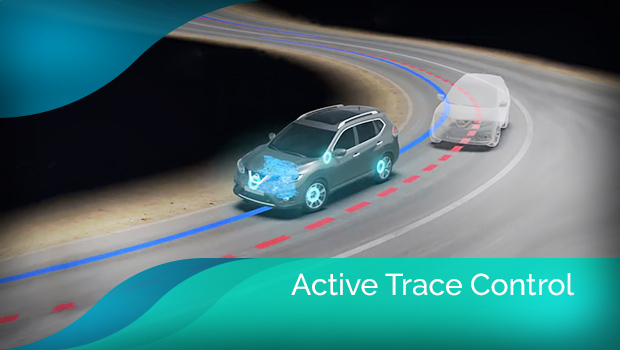Active Trace Control is one of the modern-day driver-assist features which is important for drivers who find it tough to drive around the sharp curves on a road. It improves the cornering ability of the vehicle to a significant extent and makes driving around the sharp turns absolutely trouble-free. For young and inexperienced drivers, traversing a sharp curve is not an easy job as it demands smart maneuvering of the vehicle with a careful use of acceleration, steering, and brakes, all in one motion. Active Trace Control helps inexperience young drivers and allows them to control their vehicle better while driving around sharp turns or corners.
Active Trace Control was first introduced in the Infiniti M in 2010, but it was just a basic version of this amazing driver-assist feature. Later in 2013, Nissan launched the complete Active Trace Control System in its Crossover SUV Rogue, which improved the handling of the SUV incredibly. The Active Trace Control provides sufficient braking support at the right time to maneuver a vehicle safely around sharp curves on a road.
Also read: Understanding the Traction Control System and its Capabilities
How the Active Trace Control Works?
The functionality of the Active Trace Control is fundamentally an extension of the Electronic Stability Program (ESP), which is already available in most of the modern day cars. The working of Active Trace Control is quite simple, but effective for a hassle-free ride. It works on the principle of distributing sufficient braking pressure to all wheels for added stability and control while driving around corners.
The Active Trace Control improves the driving trajectory and keeps the vehicle stable to move it in the line of a sharp curve without losing balance. Without Active Trace Control, if steering and braking are not properly controlled by the driver, the risk of hitting the sidewalk or any other obstacle along the side of the road increases as the vehicle can completely lose its track. This can prove to be life-threatening, particularly when driving through a mountain range, hill station or rocky terrain.
The Active Trace Control keeps a watch over the steering inputs of the driver and the active path that needs to be followed for safe driving around sharp curves. It automatically detects a lag in concentration or any incorrect judgment of the driver and applies brakes timely to avoid a hazardous situation. It works on the principle of simulating an experienced driver when cornering and hence improves the stability of the vehicle around sharp corners by using brakes at the right time.
There is a steering angle sensor that notices any intention of the driver to seek additional support to maneuver around the curves on a road. The steering sensor detects the difficulty faced by the driver to steer the vehicle correctly around a sharp curve and automatically applies brakes to put pressure on all four wheels, which ensures crisp handling of the vehicle even in the most challenging cornering situations. The advanced nature and amazing utility of the Active Trace Control does’t cause any premature wear of the brake-pads despite their regular use by the system.
Also read: 8 Upcoming Car Technologies to Look Out For in 2018
Active Trace Control Enhances the Driving Experience
The fundamental purpose of the Active Trace Control is to enhance the driving experience by improving the stability of the vehicle in difficult cornering situations. It automatically controls the braking and acceleration mechanism of the vehicle while driving around sharp curves, which allows the driver to steer the vehicle safely without reducing the speed of the vehicle too much.
Usefulness of Active Trace Control
Active Trace Control is of great use, especially on adventure trips where a driver has to maneuver the vehicle on rough and uneven terrains and can face dangerous turns. In such conditions, Active Trace Control comes to the assistance of the driver and provides essential braking support to maneuver easily around the sharp corners.
However, the usefulness of the Active Trace Control is not just limited to the rough terrains. It is equally responsive and useful while driving on highways, driving in wet and slippery conditions caused by heavy rain and in-city driving where you need to drive around sharp corners at the intersections on busy roads. The ultimate aim of this amazing safety technology is to make driving stress-free by optimizing the steering movements while keeping the braking mechanism in the loop when driving around sharp curves.
Importance of Driver-Assist Features in Modern Day Cars
Driver-assist features and car safety technologies provide the ultimate support in difficult driving conditions, but they can’t be taken as an alternative to driver’s attention on the road. Active Trace Control can provide support while driving around sharp curves on a road, only if the driver is attentive and driving at a moderate speed. If the driver is not attentive and not reducing the speed while driving around sharp curves, Active Traction Control would be of little help and the danger of losing control of the vehicle will increase.
Most of the safety features and driver-assist technologies don’t support autonomous driving and they need driver’s active input to respond to an emergency situation and avoid dangerous situations. This is what drivers need to understand and make good use of the modern driver-assist features such as Active Trace Control to drive safely.
If you are planning to buy a new vehicle with advanced safety technologies and improved performance features, then don’t forget that with us, you can sell your used car in just 30 minutes while all the post-sale paperwork is handled by SellAnyCar.com’s team.




